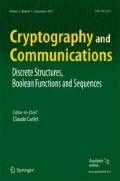Abstract
In this paper we attack a 2n-bit double length hash function proposed by Lee et al. This proposal is a blockcipher-based hash function with hash rate 2/3. The designers claimed that it could achieve ideal collision resistance and gave a security proof. However, we find a collision attack with complexity of O(23n/4) and a preimage attack with complexity of O(2n). Our result shows this construction is much worse than an ideal 2n-bit hash function.


Similar content being viewed by others
References
FIPS. FIPS 180-1 Secure Hash Standard: Federal Information Processing Standard (FIPS) Publication 180-1 National Institute of Standards and Technology, US Department of Commerce Washington D.C (1995)
Fleischmann, E., Gorski, M., Lucks, S.: Security of cyclic double block length hash functions. In: Cryptography and Coding 2009, vol. LNCS 5921, pp. 153–175. Springer-Verlag (2009)
Fleischmann, E., Gorski, M., Lucks, S.: On the security of tandem-DM. LNCS of Lecture Notes in Computer Science (including subseries Lecture Notes in Artificial Intelligence and Lecture Notes in Bioinformatics), vol. 5665, pp. 84–103. Springer Verlag, Leuven Belgium (2009)
Hattori, M., Hirose, S., Yoshida, S.: Analysis of double block length hash functions. Cryptogr. Coding Proc. 2898, 290–302 (2003)
Hirose, S.: A security analysis of double-block-length hash functions with the rate 1. Ieice Trans. on Fund. of Elect. Commun. Comput. Scie. E89A10, 2575–2582 (2006)
Hirose, S.: Some plausible constructions of double-block-length hash functions. In: Fast Software Encryption, vol. LNCS 4047, pp. 210–225 (2006)
Hohl, W., Lai, X., Meier, T., Christian W.: Security of iterated hash functions based on block ciphers. In: Advances in Cryptology - CRYPTO’93, vol. LNCS 773, pp. 379–379. Springer-Verlag, Santa Barbara, CA United states (1994)
ISO: ISO/IEC 10118 Information technology - Security techniques - Hash-functions (1994)
Knudsen, L. R., Lai, X. J., Preneel, B.: Attacks on fast double block length hash functions. J. Cryptology 11(1), 59–72 (1998)
Knudsen, L.R., Muller, F.: Some attacks against a double length hash proposal. In: ASIACRYPT 2005, pp. 462–473 (2005)
Lai, X.: On the design and security of block ciphers, vol 1 of ETH Series in Information Processing. Hartung-Gorre Verlag, Konstanz (1992)
Lai, X., Massey, J.L.: Hash functions based on block ciphers. In: Rueppel, R.A. (ed.) Advances in Cryptography-Eurocrypt’92, vol. LNCS 658, pp. 55–70. Springer-Verlag (1992)
Lee, J., Hong, S., Sung, J., Park, H.: A new double-block-length hash function using feistel structure. In: J. H. Park et al. (ed.) ISA 2009, vol. LNCS 5576, pp. 11–20 (2009)
Lee, J., Steinberger, J.: Multi-property-preserving domain extension using polynomial-based modes of operation. In: Advances in Cryptology - EUROCRYPT’10, vol. LNCS 6110, pp. 573–596. Springer-Verlag, French Riviera France (2010)
Lucks, S.: A collision-resistant rate-1 double-block-length hash function. In: Symmetric Cryptography, number 07021 in Dagstuhl Seminar Proceedings, Dagstuhl, Germany. Internationales Begegnungs – und Forschungszentrum für Informatik (IBFI), Schloss Dagstuhl Germany (2007)
Menezes, A.J., van Oorschot, P.C., Vanstone, S.A.: Handbook of Applied Cryptography. CRC Press (1997)
Merkle, R.C.: One way hash functions and DES. In: Advances in Cryptology - CRYPTO’89, vol. LNCS 435, pp. 428–446. Springer-Verlag (1989)
Nandi, M.: Towards optimal double-length hash functions. In: INDOCRYPT’05, vol. LNCS 3797, pp. 77–89. Springer-Verlag (2005)
Nandi, M., Lee, W., Sakurai, K., Lee, S.: Security analysis of a 2/3-rate double length compression function in the black-box model, pp. 243–254. Springer-Verlag (2005)
NIST: Third (final) round candidates, 2010. http://csrc.nist.gov/groups/ST/hash/sha-3/Round3/submissions-rnd3.html http://csrc.nist.gov/groups/ST/hash/sha-3/Round3/submissions-rnd3.html
Özen, O., Stam, M.: Another glance at double-length hashing. In: Cryptography and Coding, 12th IMA International Conference, Cryptography and Coding 2009, vol. LNCS 5921, pp. 176–201. Springer-Verlag, Berlin (2009)
Peyrin, T., Gilbert, H., Muller, F., Robshaw, M.: Combining compression functions and block cipher-based hash functions. In: Advances in Cryptology - ASIACRYPT 2006. 4284 468, 315–331 (2006)
Rivest, R.L.: The MD5 message digest algorithm. In: Request for Comments (RFC) 1321 Internet Activities Board Internet Privacy Task Force (1992)
Satoh, Takashi, Haga, Mio, Kurosawa, Kaoru: Towards secure and fast hash functions. IEICE Trans. Fund. Elec. Commun. Comput. Sci. E82-A(1), 55–62 (1999)
Stam, M.: Block cipher based hashing revisited. In: Fast Software Encryption 2009, vol. LNCS 5665, pp. 67–83. Springer, Berlin (2009)
Steinberger, J.P.: The collision intractability of MDC-2 in the ideal-cipher model. In: Advances in Cryptology-Proceedings of EUROCRYPT 2007, volume LNCS 4515 of Lecture Notes in Computer Science, pp. 34–51. Springer Verlag, Barcelona, Spain (2007)
Wagner, D.: A generalized birthday problem. In: Yung, M. (ed.) CRYPTO 2002, vol LNCS 2442, pp. 288–303. Springer (2002)
Xiaoyun W., Yin, Y.L., Yu, H.: Finding collisions in the full SHA-1. In: Victor Shoup, editor, Advances in Cryptology - CRPTO’05, vol LNCS 3621, pp. 17–36. Springer-Verlag, Santa Barbara, CA, USA (2005)
Xiaoyun W., Yu, H.: How to break MD5 and other hash functions. In: Cramer, R. (ed.) Advances in Cryptology - EUROCRYPT’05, vol LNCS 3494, pp. 19–35. Springer-Verlag, Aarhus, Denmark (2005)
Acknowledgments
This work was supported by NSFC (61402280) and the Key Discipine Funding (Computer Technology) of Shanghai Dian Ji University (13XKJ01 and A1-1201-14-005).
This work was supported by NSFC (61073149,61272440, 61472251), and China Postdoctoral Science Foundation (2013M531174, 2014T70417).
Author information
Authors and Affiliations
Corresponding authors
Rights and permissions
About this article
Cite this article
Luo, Y., Lai, X. & Jia, T. Attacks on a double length blockcipher-based hash proposal. Cryptogr. Commun. 7, 289–295 (2015). https://doi.org/10.1007/s12095-014-0117-2
Received:
Accepted:
Published:
Issue Date:
DOI: https://doi.org/10.1007/s12095-014-0117-2




